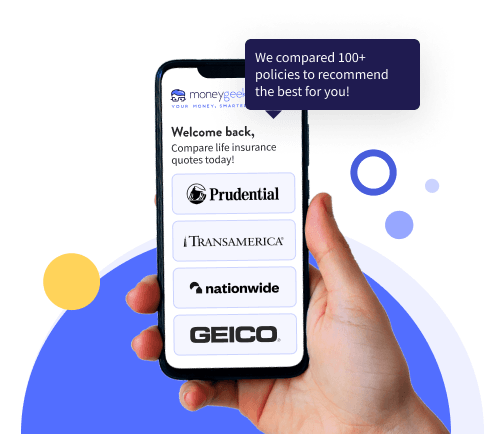Compare the Cheapest or Best Life Insurance for Your Needs
The cheapest and best life insurance policy and provider may vary per person due to differences in needs and circumstances. MoneyGeek analyzed hundreds of thousands of quotes to help you get started.
Although the cheapest policy may help save money, it may not be the best option for some people. The top life insurance company balances affordability, customer service and coverage. Compare policies from different life insurance providers based on premiums, coverage type and limits, buying process and customer satisfaction to find the best plan for you.
Factors That Can Impact Insurance Rates
Insurance providers consider various factors when calculating the cost of life insurance, including coverage amount, term length, age, gender, lifestyle and health. Learning more about these elements can help you make an informed decision.
Coverage amount
The coverage amount of a life insurance policy refers to the total death benefit, which will be paid to your chosen beneficiaries. A higher coverage increases the insurer's risk, resulting in higher premiums. Understanding the right balance between adequate protection and affordable premiums can significantly impact your financial planning.
Term length
The term length determines how long a policy stays in effect. Longer terms offer extended coverage, increasing the likelihood of a death benefit payout. This results in higher costs. Shorter terms come with lower premiums but offer limited coverage duration.
Age and gender
Younger individuals typically get more affordable life insurance costs. Since they are less likely to face imminent health issues, they generally get lower rates.
Women often receive lower rates than men. Statistically, women typically have longer life expectancies. This spreads the risk over a longer period.
Smoking status
Insurers often charge more to smokers than non-smokers. Smoking increases the likelihood of developing health complications and may lead to shorter life spans. Life insurance for smokers costs more because of this increased risk of early death benefit payouts.
Overall health
Applicant's overall health directly influences their life insurance premiums. In most cases, insurance providers require applicants to undergo a medical exam to determine their health rating. Those in poor health or who have pre-existing medical conditions face higher rates because of the increased likelihood of claiming the payout sooner.
Family health history
Insurance providers consider family health history to evaluate the potential hereditary health risks that might affect a person's longevity and determine their probability of developing a disease. Any history of significant health issues in the family can lead to higher premiums.
Life Insurance Calculator
We’ll give you a suggested amount of cover to buy in just 3 easy steps. — it's free, no personal information required, no spam.
Rates updated:
Jun 30, 2025
Compare Life Insurance Rates by Coverage and Term
The coverage level you choose determines how much your life insurance beneficiaries will receive after you pass away. A higher coverage will provide a higher payout but will also cost more. Monthly life insurance rates can also vary based on how long your policy will last. Below are the average monthly costs for different coverage amounts and term lengths.
Term Length | $100,000 | $250,000 | $500,000 | $1 Million |
|---|---|---|---|---|
10-Year Term Life Insurance | $14 | $18 | $29 | $53 |
15-Year Term Life Insurance | $17 | $23 | $30 | $55 |
20-Year Term Life Insurance | $17 | $26 | $44 | $83 |
30-Year Term Life Insurance | $29 | $43 | $62 | $123 |
**Note: The rates above are based on average costs for a 40-year-old with good health.
Compare Life Insurance Rates by State
When you compare life insurance costs, you'll find variations by state due to differences in regulations, mortality rates, and cost of living. To help you compare what coverage might cost in your area, find your state below to see average monthly rates for different ages and coverage amounts, making it easier to compare options and understand regional pricing differences.
| Alabama | $11 | $14 |
| Alaska | $13 | $15 |
| Arizona | $20 | $25 |
| Arkansas | $16 | $20 |
| California | $13 | $16 |
| Colorado | $13 | $16 |
| Connecticut | $10 | $11 |
| Delaware | $12 | $15 |
| Florida | $11 | $14 |
| Georgia | $18 | $23 |
| Hawaii | $11 | $15 |
| Idaho | $17 | $21 |
| Illinois | $12 | $14 |
| Indiana | $18 | $22 |
| Iowa | $18 | $22 |
| Kansas | $18 | $23 |
| Kentucky | $10 | $12 |
| Louisiana | $19 | $23 |
| Maine | $11 | $13 |
| Maryland | $9 | $10 |
| Massachusetts | $11 | $15 |
| Michigan | $11 | $14 |
| Minnesota | $12 | $14 |
| Mississippi | $18 | $21 |
| Missouri | $11 | $14 |
| Montana | $11 | $13 |
| Nebraska | $11 | $14 |
| Nevada | $12 | $14 |
| New Hampshire | $8 | $9 |
| New Jersey | $10 | $11 |
| New Mexico | $16 | $19 |
| New York | $7 | $8 |
| North Carolina | $11 | $14 |
| North Dakota | $18 | $24 |
| Ohio | $11 | $14 |
| Oklahoma | $17 | $21 |
| Oregon | $8 | $9 |
| Pennsylvania | $11 | $14 |
| Rhode Island | $8 | $9 |
| South Carolina | $11 | $14 |
| South Dakota | $16 | $21 |
| Tennessee | $12 | $14 |
| Texas | $20 | $24 |
| Utah | $11 | $13 |
| Vermont | $11 | $13 |
| Virginia | $13 | $15 |
| Washington | $14 | $17 |
| West Virginia | $10 | $13 |
| Wisconsin | $12 | $15 |
| Wyoming | $12 | $14 |
Why Compare Life Insurance?
Insurers calculate life insurance premiums differently. Costs may vary widely even for the same person. To find the best price, compare personalized quotes from multiple providers. At MoneyGeek, we offer tools and guides to help you find a policy that fits your budget and coverage needs. Use our tools for a quick comparison of personalized quotes.
Why Trust MoneyGeek? We analyzed 1,488 life insurance quotes alongside customer satisfaction ratings, financial stability reports, product offerings and more to determine the best life insurance companies for a variety of needs.
Coverage costs and company information for life insurance providers were updated in 2025.
How to Compare Life Insurance Quotes
Shopping around helps you find the cheapest and best plans. MoneyGeek outlined key steps you can take to find the right life insurance policy for your coverage needs.
- 1
Consider your needs.
To accurately assess how much life insurance you need, consider all the expenses that you want your policy to cover. Depending on your circumstances, you may want to have coverage for income replacement, debt repayment, funeral costs and/or retirement funding. After determining your financial obligations, subtract any existing assets to find the right coverage amount.
- 2
Choose the right type of policy.
It is also important to choose the right type of policy. A term life insurance plan offers coverage for a specified term. This is usually anywhere from one to 30 years, with a few companies offering a 40-year term. Once the term policy expires, you can either renew it, convert it into a whole policy or allow it to terminate.
If you prefer lifelong coverage, a permanent policy may be right for you. This type of policy also offers a cash value benefit, which you can access while you're alive. Permanent life insurance, such as whole life insurance and universal life insurance, are usually more expensive than term plans.
- 3
Research average costs and discount opportunities.
Explore average costs for the coverage level and type of policy you want. You can start by looking at annual or monthly premiums. This will give you an idea of how much your policy may cost. Look for different discounts that can help you save money. These may differ by company, so make sure you check from multiple providers. Understanding the factors that affect premiums, like age, health and lifestyle, can also help you identify potential savings.
- 4
Find out which providers may be best for you.
Research and compare life insurance companies to determine which best aligns with your financial profile and coverage needs. Consider the cheapest and best providers based on your profile. To help you get started, utilize online life insurance calculators and tools to estimate premiums specifically tailored to your age, health status, and insurance requirements to find the most affordable options.
- 5
Get multiple provider quotes from different avenues.
Compare personalized quotes from at least three different companies to find the provider with the coverage you need at a price you can afford. Make sure you're getting quotes for the same coverage amount, term length and type of policy. Consider different avenues such as online brokers, direct insurance companies and local agents to see how quotes may vary and get the most favorable rates.
Review the policy offers and look at other fees or costs that might be involved. Be sure to compare policy provider ratings too. We recommend favoring carriers with high financial strength ratings.
Read MoneyGeek's Reviews on Life Insurance Companies
Exploring your options can help you find the right life insurance policy. While cost is an important consideration, you should also check a company's customer satisfaction and financial stability to ensure value for money. Browse below to see MoneyGeek's review for each provider.
Frequently Asked Questions About Comparing Life Insurance
You may have questions during the process of shopping for life insurance, comparing quotes and choosing the right coverage for you. Click on some of the most frequently asked ones below to learn more.










